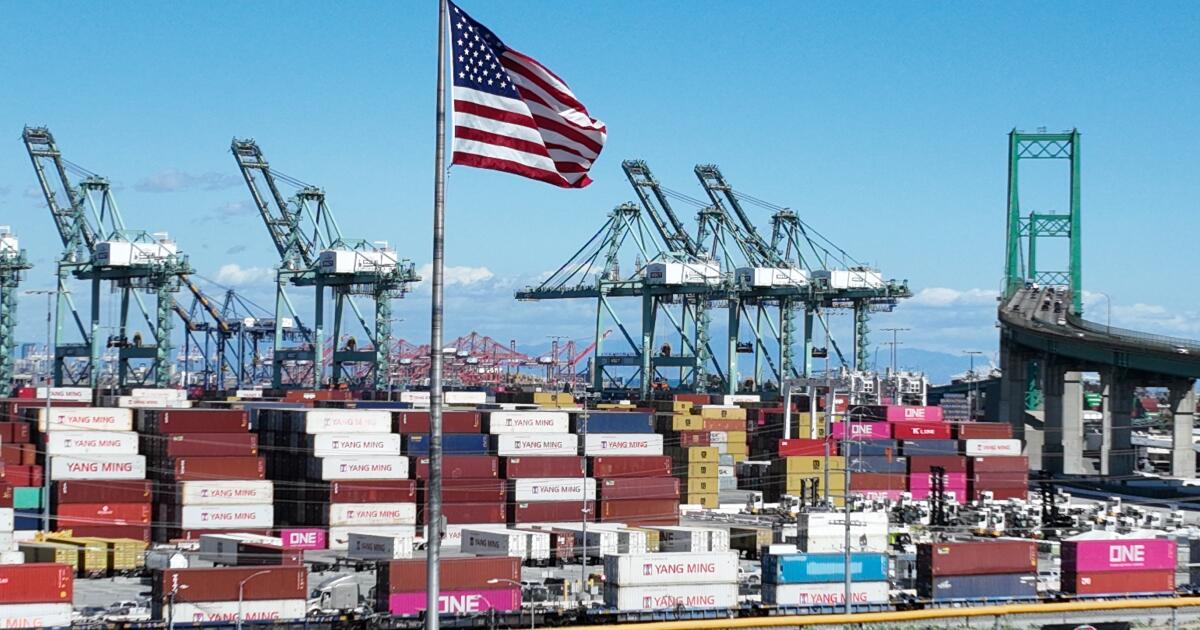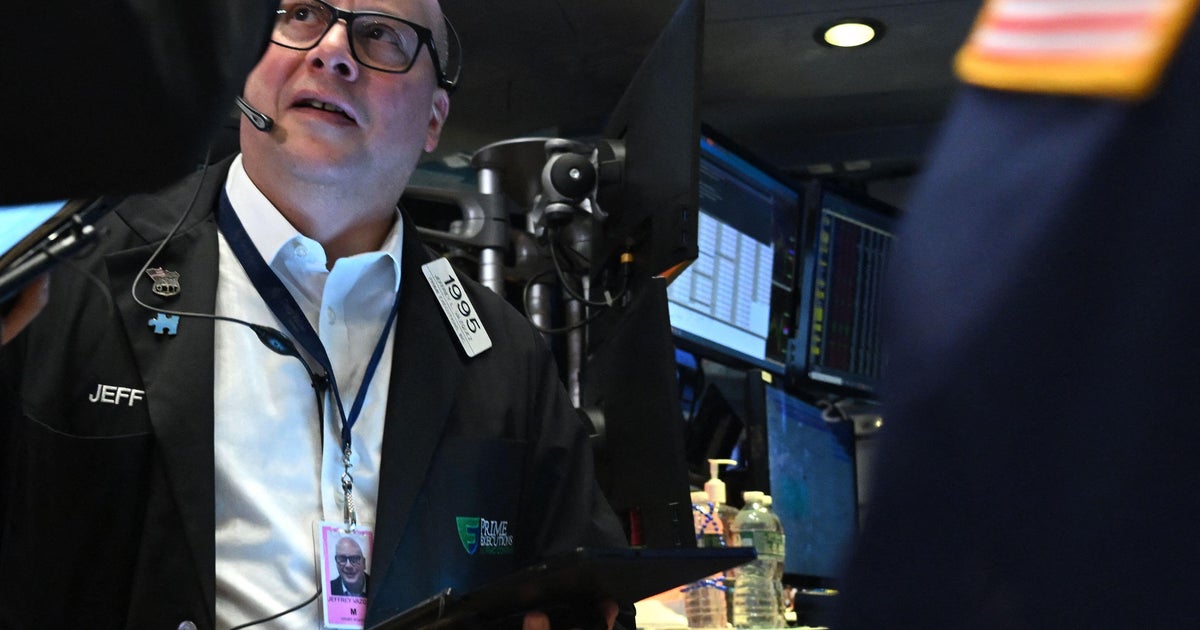
As a center of global trade L.A. could be in for a bumpy ride after Trump tariffs
The Los Angeles-Long Beach port complex is one of the nation’s leading arteries of trade, handling about a third of the nation’s container imports and exports, placing it at ground zero of President Trump’s trade war with the rest of the world.
With Trump’s across-the-board 10% tariffs worldwide and higher “reciprocal” tariffs imposed on a number of Asian trading partners, economists say it’s likely that one of the key drivers of the Los Angeles-area economy — trade — will be hit hard.
“The single most important part of the economy, in terms of employment, in terms of economic activity in the L.A. area, is logistics, basically the imports, exports, shipment of goods, and one of the second is manufacturing,” said economist Kevin Klowden of the Milken Institute in Santa Monica. “These tariffs are very, very important because they have a material effect on supply chains and everything else.”
The tariffs include additional duties of 24% on Japan, 25% on South Korea and a 34% tariff on China, on top of a 20% tariff that Trump imposed on that nation over illegal imports of the deadly drug fentanyl.
Canada and Mexico were excluded from both the baseline and reciprocal tariffs, which could ease the effect at the grocery store. Most U.S. produce imports come from Mexico and Canada, including avocados, cucumbers and mushrooms.
But the countries still face 25% levies on certain goods and 25% tariffs on imported cars and light trucks. Car buyers across South California scrambled this week to make purchases ahead of the tariffs.
It’s unclear how many of the tariffs or at which rate they will ultimately stick, as countries seek to negotiate with the Trump administration.
But the announcement Wednesday rattled investors, with the Standard & Poor’s 500 index dropping 4.8% on Thursday, marking the steepest decline since 2020. The Dow Jones industrial average declined 4%, and the Nasdaq composite fell 6%. The dollar also slid in value as investors piled into the euro, yen and Swiss franc. It also prompted analysts to raise their inflation forecasts and lower their growth expectations for the U.S. economy.
Leading trading partners, China and the European Union, which is facing a 20% hit, are mulling over retaliatory actions that could lead to an all-out trade war and cripple imports and exports.
Escalating trade tensions have been felt at the ports of Los Angeles and Long Beach, which set records for cargo traffic in November as companies loaded up on goods in anticipation of the tariffs, which on the campaign trail Trump promised to impose.
That rush over the last several months is over and the tariffs could lead to a 10% drop in cargo volume moving through the Port of Los Angeles later this year, Executive Director Gene Seroka said.
“This is the widest sweeping tariff regime we’ve witnessed,” Seroka said. “Fewer containers coming to the Port of Los Angeles means fewer jobs.”
As Los Angeles communities recover from the devastating wildfires, the city is particularly reliant on imported goods, Seroka added.
“We need lumber from Canada; appliances from Mexico; aluminum, steel, copper and furniture from China. All of those commodities and more were hit with the highest tax we’ve ever seen in yesterday’s announcement,” he said.
Any slowdown at the ports would reach deep into the L..A.-area economy. The transportation, trade and utilities sector is one of the county’s largest employment clusters, with an estimated 830,000 workers last year, according a report by the Los Angeles County Economic Development Corp.
“There will be fewer employment opportunities at the ports and throughout the supply chain that goes from the ports well into the Inland Empire, where huge numbers of containers are processed each day,” said economist Jock O’Connell, international trade advisor at L.A.’s Beacon Economics.
Although manufacturing in Los Angeles has been declining for decades, it employed an estimated 313,000 workers last year, making it a leading sector in the county’s nearly $1-trillion economy, according to the LAEDC.
The industry is diverse, spanning apparel, metal products, electronics, processed food products and other goods. Some industries are thriving, including a new generation of South Bay aerospace companies founded by former SpaceX employees and others.
Many of those companies rely on components often manufactured in Asia. Although some of those suppliers have diversified out of China since Trump’s last trade war in 2018, they typically landed in Southeast Asian countries such as Vietnam and India that were targeted by Wednesday’s “reciprocal tariffs.”
That could raise the cost of domestically produced goods sold in the U.S. and for export.
“It’s going to have a huge, huge impact on manufacturing and supply chains throughout throughout California.,” Klowden said. “We don’t have the specialized manufacturing for all of these supply chains, and certainly not at cost in the U.S.”
Last year, the state exported nearly $160 billion in manufactured goods, with the leading export category of computer and electronic products accounting for $47.9 billion of it, according to the Office of the United States Trade Representative.
Other top exports included $18.4 billion in machinery and $16.2 billion in chemicals — all of which would be vulnerable to retaliation by trading partners angered over Trump’s tariffs.
Meanwhile, U.S. companies with manufacturing overseas face import tariffs.
iPhone maker Apple of Cupertino, Calif., has spent billions diversifying its manufacturing out of China, into India, to service that country’s market but also for worldwide distribution — only to grapple with its 27% reciprocal tariff imposed by Trump.
“The tech sector is fundamentally facing the fact that it’s really dependent on these global supply chains,” Klowden said.
Silicon Valley also is facing possible retaliation from the European Union, with France pushing for the bloc to hit the tech services sector with duties. France adopted a tax on digital services in 2019, which hit Alphabet Inc.’s Google, Meta Platforms Inc. and others.
California also is the nation’s largest exporter of agriculture goods, with exports nearly hitting $25 billion in 2022, according to the U.S. Department of Agriculture. Tree nuts such as almonds accounted for $8.1 billion of that, with billions more in fruits, vegetables and other products.
Those exports, like manufactured goods, could be susceptible to retaliatory tariffs. The top five leading export markets for the state’s agricultural goods were Canada, the European Union, China, Japan and Mexico, respectively, in 2022, according to the California Department of Food and Agriculture.
China on Thursday urged Trump to immediately lift the new tariffs or face swift countermeasures. O’Connell said it is more likely that if China targets agricultural exports, it might focus on soybeans grown in the midwest for maximum political effect, rather than California products.
California’s wine industry, meanwhile, could benefit from tariffs on foreign imports, which have jumped 60% since 2010 to $7.1 billion last year, but suffer from retaliatory tariffs on exports, which totaled $1.25 billion last year across all states, with almost half going to Canada and the United Kingdom.
Trump and his economics team have acknowledged the imposition of the tariffs will result in economic turbulence, but they contend that will be the price for luring manufacturing back into the country by both American and foreign companies.
Some companies have announced major U.S. investments. The French shipping firm CMA CGM, for example, announced a $20-billion U.S. investment, including expanding its Los Angeles container ports.
Klowden said the challenge is the inflationary effects of the tariffs will begin immediately, but it could take years for any payoff.
China accounted for 77% of toy imports in 2023, with the National Retail Federation projecting that prices could rise by more than 50% depending on the final tariff level. Also, expected to rise in price are apparel, shoes and big-ticket items such as laptops, dishwashers and washing machines.
“What President Trump is basically dealing with is a clock, that enough new jobs will be created quickly enough so that the general public is going to feel that they’re gaining something out of it” Klowden said.
Mark Zandi, chief economist of Moody’s Analytics, predicts that the tariffs will trigger a recession rather than a manufacturing renaissance.
“These are very large tariff increases, and I think they will invite retaliation by our trading partners, and I think it’s going to be tough to digest,’’ Zandi said. “It’s a very large tax on the American economy.”
Times staff writer Caroline Petrow-Cohen and Bloomberg News contributed to this report.










